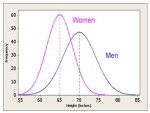No, the strongest 10% of women are not about as strong as the weakest 10% of men. In real life there is a physical strength difference between the genders, but your statement vastly overinflates that difference to the point where you'd have an "average" man being stronger than the strongest of women if what you said were true, and that just isn't the case.
True i was posting this generalizing a bit to much, These are of course average numbers. If you take trained women who do weightlifting or some other sports as professionals, then the average man is not that strong. But if you take statistic distributions then my statement is still true, only very few women are top athlets.
Even an weak man belonging to the weakest 10% is still stronger than 90% of the women. That is a fact that i read in a study about violence against women, which makes violence against women even more unacceptable than it is since this fact shows that it is hard for many women to put up physical defense in such a damable crime. Since it is decades ago i read this i cannot cite a source anymore but you could Google a bit to find out some numbers which might be different already nowadays.

